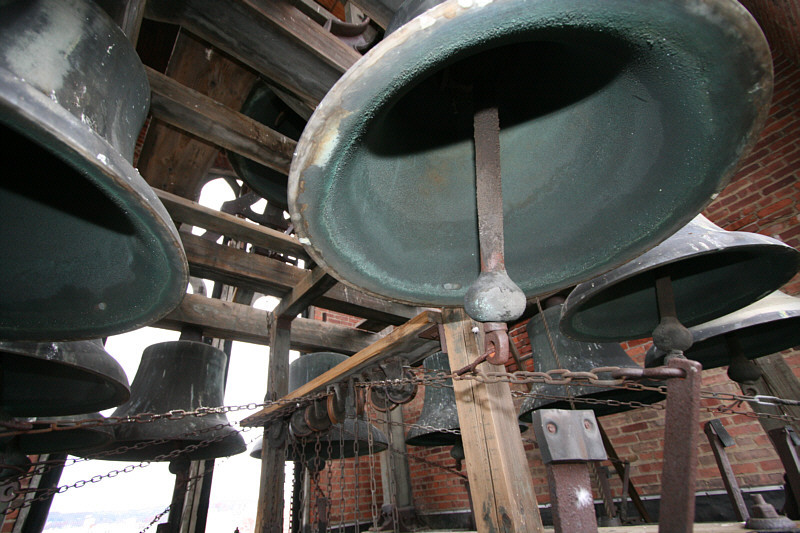 |
 |
|
The Church Bells of Broome County
Sometime around 1870 in the dead of winter an ox-sledge left the Jones Foundry in Troy, New York, just north of Albany. It was headed for a small village on the banks of the Susquehanna River, 125 miles to the southwest. The sledge carried precious cargo… a 2,000-pound bronze bell for St. Luke’s Episcopal church in Harpursville. Today, it still hangs in the belfry. The huge wooden bell wheel is still intact and a frayed foot-long section of rope long ago chewed through by mice is tied to the top. Standing next to this silent, hidden treasure it’s impossible to resist the temptation… a firm tap brings it to life with a magnificent rich tone as clear as the day it was installed. Just around the corner is the United Methodist Church. Its bell is inscribed: “Presented to the M.E. Church, Nineveh, NY, by Reuben Lovejoy, A.D. 1899.” Lovejoy, a Civil War veteran, donated it to a nearby Nineveh church, and when that church was later demolished, the bell was salvaged and moved to Harpursville. In the early 1900’s John and Hilda Webb were active members of the Methodist church in Ouaquaga, north of Binghamton. Hilda passed away in 1916 and when the original church bell broke the following year, John had a new one built and donated it in her memory. The inscription reads: “Presented by John W. Webb in memory of his wife Hilda Hunt Webb, April 1917.” Kirkwood resident Susan Mercer has a special connection with this bell. Originally from Ouaquaga, “I grew up in that church,” said Mercer. “As a teenager, I was a bell ringer for a while. I loved it and always gave the old bell a couple more rings than I probably should have,” she said. It may have been one of those extra rings that did it – eventually the wooden wheel broke. A temporary fix allows the bell to be used until the wheel is repaired. Eleven bells hang in the tower of First United Methodist Church of Endicott. They range in weight from 250 pounds to well over a ton and are tuned to a diatonic scale with a few extra notes thrown in. The clapper of each bell is connected to a chain that passes over a pulley and runs straight down through two floors below to a large wooden cabinet with a series of levers on the front. This is the “keyboard,” but each “key” is the size of a baseball bat. It has to be. Producing music with this contraption is no easy task. Each lever has to be pushed down about 18 inches to make the bell sound, and even the simplest of tunes creates quite a workout for the performer. It literally shakes the floor. Of course there’s nothing subtle about it… every note, right or wrong, instantly reverberates throughout the entire surrounding community. A virtually identical instrument is in the tower of Christ Episcopal Church in Binghamton. This tower is lighted at night, and if you look closely you can see the bells and how they are mounted on the frame. Thirteen chimes hang in the tower of St. James Catholic Church in Johnson City. At some point the mechanisms on these bells were modified to make the chimes playable with a traditional keyboard. These instruments are often referred to as carillons, but as Bob Butler who maintains the bells at First United Methodist explains, it takes at least 23 bells to make a true carillon. “These instruments are called ‘chimes’.” It’s not unusual to hear music performed on church bells, but most of what we hear now is pre-recorded and played through loudspeakers. There is no comparison to the real thing. It is a rare treat to witness a performance on an original, fully mechanical instrument, or better yet, to actually play one yourself! It was a cool fall day, a mild breeze blew from the south and a gentle rain was falling. All was quiet on the streets of Endicott. Then it happened… first one bell, then another. The levers were flying, the floor was shaking and the chimes were ringing. Strains of Amazing Grace echoed through the community. It’s Amazing that I got through it without a wrong note, the execution definitely lacked Grace, but oh, How Sweet the Sound! Like the communities around them, churches have seen much change over the years. But through it all there is one constant, and it can be found high in the towers of many of these structures. Whether the church is large or small, urban or rural, thriving or abandoned, chances are there is a bronze bell hanging up there in the dark. Each one has a story, and those that have fallen silent just wait for the day they will sing again. |
